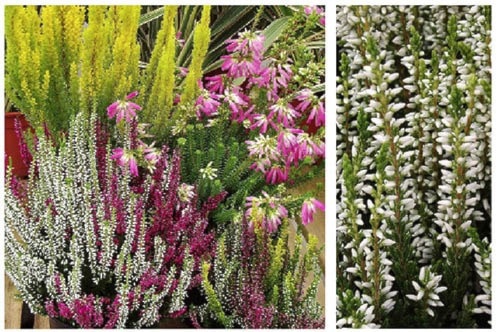Well, it’s that time of year, when the planters by the front door or around the patio are looking a bit tired – those petunias, geraniums and lobelia have almost ‘given up the ghost’ and there’s more mildew than flowers.
It might be that you have a few permanent features such as heuchera, ivies or evergreen grasses that will live for another day, but what do you do with those gaping holes once the summer flowers are discarded?
Look no further than heather, which, providing you don’t over-water them (which is sure death), will give you months of beautiful flowers or foliage despite the oncoming colder weather.
There are basically three good choices available at most garden centres, including Scotch heathers (Calluna vulgaris) that come in a ‘bud bloomer’ form or have vibrant winter foliage after flowering.
The other two include the winter heathers, with both Erica carnea and Erica x darleyensis providing months of cold-season blooms in colours ranging from white, shell pink, rose and deep magenta.
For the collectors among you, there are even a few tender upright heathers, such as Erica arborea ‘Golden Joy,’ with its eye-scorching yellow foliage and the even rarer Erica x ‘African Fanfare,’ with its showy tips of elongated pink flower clusters. Both of these make excellent centrepieces until late autumn, when they will need to be sheltered in a cool greenhouse or sunroom for winter.
Some choice standard Scotch heathers to look for include ‘Firefly’ and ‘Hoyerhagen’, both of which are still in bloom, but also have deep gold foliage that shifts to a vivid reddish-orange in the colder weather.
The others to look for are the ‘bud bloomers’, a class of Scotch heather whose flower buds do not open and as a result the colour often lasts from now to Christmas, and even beyond. These are available in mixed pots where reds, pinks, whites, purples and gold foliage are blended to provide some contrast and much needed autumn focus.
Single cultivars (such as ‘Athene’, ‘Lianne’, ‘Alicia’ and ‘Selly’) are also available for those of you who like to fine tune your colour combinations.
The winter-flowering heathers come in the generally lower growing Erica carnea or the hybrid group Erica x darleyensis, which is a cross of E. carnea and Erica erigena.
The best of the former species includes ‘Springwood White’ and ‘Pink’, ‘Tanja’ (deep rose), ‘Wintersonne’ (vivid lilac-pink), ‘December Red’, ‘Golden Starlet’ (white with gold foliage), ‘Isabell’ (white) and ‘Myretoun Ruby’ (crimson-purple).
By far the most popular winter heather is Erica x darleyensis ‘Kramer’s Red’ (or ‘Kramer’s Rote’), with its deep magenta flowers that never seem to fade.
Other worthy x darleyensis hybrids include ‘White Perfection’, ‘Jenny Porter’ (lilac with cream spring tips), ‘Furzey’ (lilac-pink) and ‘Jack H. Brummage’ (gold foliage).
Lastly, I would like to take a little time to recognize one of our premier heather growers, David Wilson of Chilliwack. All of the heathers pictured with today’s article were lovingly grown by him, with many cultivars, such as the ‘Golden Joy’ tree heather (which he discovered), and the ‘African Fanfare’ being just a handful of rarities that he has introduced locally.
The praise for this beautiful stock should go solely to the hard work of a few dedicated horticulturists, such as David.
When I see my last delivery of near perfect bud bloomers, I know I am looking at decades of growing experience, and before he retires I just wanted to thank him for it.
Mike Lascelle is a local nursery manager
and gardening author
